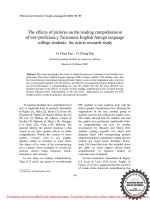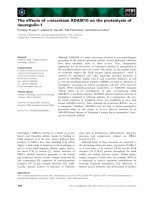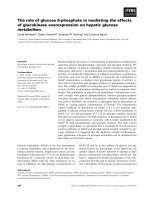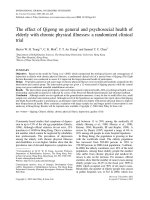The effects of martial arts participation on mental and psychosocial health outcomes: A randomised controlled trial of a secondary school-based mental health promotion program
Bạn đang xem bản rút gọn của tài liệu. Xem và tải ngay bản đầy đủ của tài liệu tại đây (794.66 KB, 7 trang )
Moore et al. BMC Psychology
(2019) 7:60
/>
STUDY PROTOCOL
Open Access
The effects of martial arts participation on
mental and psychosocial health outcomes:
a randomised controlled trial of a
secondary school-based mental health
promotion program
Brian Moore1 , Dean Dudley2 and Stuart Woodcock3*
Abstract
Background: Mental health problems are a significant social issue that have multiple consequences, including
broad social and economic impacts. However, many individuals do not seek assistance for mental health problems.
Limited research suggests martial arts training may be an efficacious sports-based mental health intervention that
potentially provides an inexpensive alternative to psychological therapy. Unfortunately, the small number of relevant
studies and other methodological problems lead to uncertainty regarding the validity and reliability of existing
research. This study aims to examine the efficacy of a martial arts based therapeutic intervention to improve mental
health outcomes.
Methods/design: The study is a 10-week secondary school-based intervention and will be evaluated using a randomised
controlled trial. Data will be collected at baseline, post-intervention, and 12-week follow-up. Power calculations indicate a
maximum sample size of n = 293 is required. The target age range of participants is 11–14 years, who will be recruited
from government and catholic secondary schools in New South Wales, Australia. The intervention will be delivered in a
face-to-face group format onsite at participating schools and consists of 10 × 50–60 min sessions, once per week
for 10 weeks. Quantitative outcomes will be measured using standardised psychometric instruments.
Discussion: The current study utilises a robust design and rigorous evaluation process to explore the intervention’s
potential efficacy. As previous research examining the training effects of martial arts participation on mental health
outcomes has not exhibited comparable scale or rigour, the findings of the study will provide valuable evidence
regarding the efficacy of martial arts training to improve mental health outcomes.
Trial registration: Australian New Zealand Clinical Trials Register ACTRN12618001405202. Registered 21st August 2018.
Keywords: Mental health, Martial arts, Resilience, Self-efficacy, Preventative medicine, Alternative and complimentary
therapies
* Correspondence:
3
Griffith University, School of Education and Professional Studies Faculty of
Arts, Education, and Law, Brisbane, QLD 4122, Australia
Full list of author information is available at the end of the article
© The Author(s). 2019 Open Access This article is distributed under the terms of the Creative Commons Attribution 4.0
International License ( which permits unrestricted use, distribution, and
reproduction in any medium, provided you give appropriate credit to the original author(s) and the source, provide a link to
the Creative Commons license, and indicate if changes were made. The Creative Commons Public Domain Dedication waiver
( applies to the data made available in this article, unless otherwise stated.
Moore et al. BMC Psychology
(2019) 7:60
Background
Mental health problems are a significant social issue that
have multiple consequences; ranging from personal distress, disability, and reduced labour force participation; to
wider social and economic impacts. The annual global
cost of mental health problems was estimated as $USD
2.5 trillion by the World Health Organisation [1]; and the
annual cost of mental illness in Australia has been estimated as $AUD 60 billion [2]. These costs are projected
to increase 240% by 2030 [1].
However, for a variety of reasons including stigmatisation of mental health and the cost and poor availability
of mental health treatment, many individuals do not
seek assistance for mental health problems [3]. Consequently, it is important to consider the application of
alternative and complimentary therapies regarding mental
health treatment. Martial arts training may be a suitable
alternative, as it incorporates unique characteristics
including an emphasis on respect, self-regulation and
health promotion. Due to this, martial arts training could
be viewed as a sports-based mental health intervention
that potentially provides an inexpensive alternative to
psychological therapy [4]. However, the efficacy of this
approach has received little research attention [5].
Existing martial arts research has mostly focused on
the physical aspects of martial arts, including physical
health benefits and injuries resulting from martial arts
practice [6], while few studies have examined whether
martial arts training addressed mental health problems
or promoted mental health and wellbeing. Several studies report that martial arts training had a positive effect
reducing symptoms associated with anxiety and depression. For example: (a) training in tai-chi reduced anxiety
and depression compared to a non-treatment condition
[7], (b) karate students were less prone to depression
compared to reported norms for male college students
[8], and (c) a study examining a six-month taekwondo
program reported significantly reduced anxiety [9].
Similarly, several studies report martial arts training promotes characteristics associated with wellbeing including: (a) a group of female participants reported higher
self-concept compared to a comparison group after
studying taekwondo for 8 weeks [10], and (b) a sixmonth taekwondo program found increased self-esteem
following the intervention [9].
A recent meta-analysis examining the effects of martial
arts training on mental health examined 14 studies and
found that martial arts training had a positive effect on
mental health outcomes (Moore, B., Dudley, D. &
Woodcock, S. The effect of martial arts training on mental health outcomes: a systematic review and metaanalysis, Under review). The study found that martial arts
training had a medium effect size regarding reducing
internalising mental health problems, such as anxiety
Page 2 of 7
and depression; and a small effect size regarding increasing wellbeing.
However, despite generally positive findings the research
base examining the psychological effects of the martial
arts training exhibits significant methodological problems
[11, 12]. These include definitional and conceptual issues,
a reliance on cross-sectional research designs, small
sample sizes, self-selection effects, the use of self-report
measures without third party corroboration, absence of
follow-up measures, not accounting for demographic
differences such as gender, and issues controlling for the
role of the instructor. These issues may limit the generalisability of findings and suggest uncertainty regarding the
validity and reliability of previous research.
This study seeks to examine the relationship between
martial arts training and mental health outcomes, while
addressing the methodological limitations of previous
studies. The intervention examined by the study is a
bespoke programme based primarily on the martial art
taekwondo and incorporating psycho-education developed
for the intervention. Importantly, this study aims to
examine the efficacy of a martial arts based therapeutic
intervention to improve mental health outcomes.
Methods/design
Study design
This study is a 10-week secondary school-based intervention and will be evaluated using a randomised controlled
trial. Ethics approval has been sought and obtained from an
Australian University Human Research Ethics Committee,
the New South Wales (NSW) Department of Education,
and the Catholic Education Diocese of Parramatta. The
study is registered with the Australian and New Zealand
Clinical Trials Registry (ACTRN12618001405202). The
study protocol was also reviewed externally by school psychologists employed by the NSW Department of Education.
Researchers will conduct baseline assessments at participating schools after the initial recruitment processes.
Following baseline assessments and randomisation, the
intervention group will receive the intervention after
which post-intervention assessment will be conducted. A
12-week post-intervention (follow-up) assessment will
also be conducted. The control group will receive the
same intervention program after the first post-intervention assessment and will not be measured at follow-up. The design, conduct and reporting of this
study will adhere to the Consolidation Standards of
Reporting Trials (CONSORT) guidelines for a randomised controlled trial [13]. Participants and caregivers
will provide written informed consent.
Sample size calculation
Power calculations were conducted to determine the
sample size required to detect changes in mental health
Moore et al. BMC Psychology
(2019) 7:60
related outcomes resulting from martial arts training.
Statistical power calculations assumed baseline-post-test
expected effect size gains of d = 0.3, and were based on
90% power with alpha levels set at p < 0.05. The minimum completion sample size was calculated as n = 234
(intervention group: n = 117, control group: n = 117). As
participant drop-out rates of 20% are common in randomised controlled trials [14], the maximum proposed
sample size was n = 293 (intervention group: n = 147,
control group: n = 146).
Page 3 of 7
(b) Warm up – including jogging, star jumps, push ups,
and sit ups;
(c) Stretching – including hamstring stretch, triceps
stretch, figure four stretch, butterfly stretch, lunging
hip flexor stretch, knee to chest stretch, and
standing quad stretch; and,
(d) Technical practice – including stances, blocks,
punching, and kicking.
Additionally, intervention sessions intermittently include
(alternated throughout the program):
Recruitment and study participants
To be eligible to participate in the study, schools must
be government or catholic secondary schools in NSW,
Australia. All eligible schools (n = 140) will be sent an
initial email with an invitation to participate in the study.
Schools that respond to the initial email will be pooled
and receive a follow up call in random order from the
project researchers to discuss whether they would like to
participate in the study. The first five schools that demonstrate interest will then be recruited into the study.
Inclusion criteria for participation in the study includes:
(a) participants are currently enrolled in grades 7 or 8, and
(b) participants are within an age range 11–14 years.
Exclusion criteria: concurrent martial arts training will exclude participation in the study, however prior experience
of martial arts training is not an exclusion criteria. All
students at participating schools who meet these criteria
will be invited to participate in the study. Participant and
caregiver information and consent forms will be provided
to students. Two follow-up letters will be sent subsequently at 2 week intervals. Students who respond to
the invitation will be pooled and randomly allocated into
the study, or not included in the study.
Randomisation into intervention and control group
will occur after baseline assessments. A simple computer
algorithm will be used to randomly allocate participants
into intervention or control groups. This will be performed by a researcher not directly involved in the
study. Figure 1 provides a flowchart of the timeline for
the study.
Intervention design
Intervention description
The intervention will be delivered in a face to face group
format onsite at participating schools. The intervention
will be 10 × 50–60 min sessions, once per week for 10
weeks. Each intervention session will include:
(a) Psycho-education – guided group based discussion.
Topics include respect, goal-setting, self-concept
and self-esteem, courage, resilience, bullying and
peer pressure, self-care and caring for others,
values, and, optimism and hope;
(e) Patterns practice – a pattern is a choreographed
sequence of movements consisting of combinations
of blocks, kicks, and punches performed as though
defending against one or more imaginary
opponents;
(f) Sparring – based on tai-chi sticking hands exercise
(which has been included as an alternative to
traditional martial arts sparring); and
(g) Meditation – based on breath focusing exercise.
In the final session the intervention will conclude with
a formal martial arts grading where participants will be
awarded a yellow belt subject to demonstration of
martial arts techniques (stances, blocks, punching, and
kicking) and the pattern learnt during the program.
While it is desirable for participants to attend all 10
sessions to achieve intervention dose, it is unrealistic to
assume all sessions will be attended. Research has
suggested that determining an adequate intervention
dose in health promotion programmes can be based on
level of participation and whether participants did well
[15]. In the current study intervention dose will be
assumed if participants successfully complete the formal
grading and are awarded a yellow belt. It is important to
note that aggressive physical contact is not part of the
intervention program. The intervention will be delivered
by a (1) registered psychologist with minimum 6 years’
experience, and (2) 2nd Dan/level black-belt taekwondo
instructor with minimum 5 years’ experience. Materials
used during the intervention will include martial arts
belts (white and yellow), and martial arts training equipment (for example strike paddles, strike shields).
Theoretical framework
The intervention development and implementation will
be based on a traditional martial arts model, dichotomous health model, and social cognitive theory. Research examining the relationship between the martial
arts and mental health has typically used a bipartite
model [16] which distinguishes between traditional and
modern martial arts. The intervention is based on a
traditional martial arts perspective, which emphasizes
Moore et al. BMC Psychology
(2019) 7:60
the non-aggressive aspects of martial arts including
psychological and philosophical development [17].
The absence of an explicit health model is a significant
methodological limitation of previous research examining the mental health outcomes of martial arts training.
The dominant models of mental health are based on the
homeostatic assumption that normal health reflects the
tendency towards a relatively stable equilibrium; and
that the dysregulation of homeostatic processes causes
Fig. 1 Flowchart of study
Page 4 of 7
ill-health [18]. These models can be defined dichotomously as having a: (1) pathological basis (deficit model)
which refers to the presence or absence of disease based
symptoms such as depression or anxiety; and (2)
wellbeing basis (strengths model) which refers to the
presence or absence of beneficial mental health characteristics such as resilience or self-efficacy. While considering both aspects of the mental health continuum, this
study was particularly interested in the strengths model
Moore et al. BMC Psychology
(2019) 7:60
and examined the wellbeing characteristics of resilience
and self-efficacy.
Social cognitive theory suggests that knowledge can
be acquired through the observation of others in the
context of social interactions, experiences, and media
influences; and explains human behaviour in terms of
continuous reciprocal interaction between personal
cognitive, behavioural, and environmental influences
[19]. The theory is useful for explaining the learning
processes in the martial arts, which include: (a)
modelling – where learning occurs through the observation of models; (b) outcome expectancies – to learn
a modelled behaviour the potential outcome of that
behaviour must be understood (for example, the
anticipation of rewards or punishment); and (c) selfefficacy – the extent to which an individual believes
that they can perform a behaviour required to produce
a particular outcome [19].
The study’s theoretical framework incorporating a
traditional martial arts model, dichotomous health
model and social cognitive theory facilitates examination
of the effects of martial arts training on mental health,
ranging from mental health problems to factors associated with wellbeing such as resilience and self-efficacy. Further, the framework may determine the
efficacy of martial arts training as an alternative
mental health intervention that improves mental
health outcomes.
Page 5 of 7
Resilience
The primary outcome measured by the CYRM will be
mean total resilience. Additionally, the CYRM will
measure the following secondary outcomes: individual
capacities and resources, relationships with primary
caregivers, and contextual factors.
Resilience was selected as a primary outcome as it
is a current focus of research regarding psychological
strengths, but has not been examined regarding the
effect of martial arts training. The CYRM-28 was
used in the study as it efficiently operationalises the
theoretical aspects of resilience in a valid and reliable
manner, but is shorter than comparable scales (for
example the Resilience Scale for Children and Adolescents [24]).
Self-efficacy
The primary outcome measured by the SEQ-C will be
mean total self-efficacy. Additionally, the SEQ-C will
measure the following secondary outcomes: academic
self-efficacy, social self-efficacy, and emotional selfefficacy.
Self-efficacy was selected as a primary outcome as
this operationalised a relevant component of social
cognitive theory, which is important regarding the
hypothesised learning processes in the intervention.
The SEQ-C was used in the study as it operationalises self-efficacy for adolescents in an educationally
relevant context.
Outcomes
Evaluation of the intervention program will involve a
variety of standardised psychometric instruments to
report on mental health related outcomes. Instruments
include the Strengths and Difficulties Questionnaire
(SDQ) [20], Child and Youth Resilience Measure (CYRM)
[21], and Self-Efficacy Questionnaire for Children (SEQC) [22]. All outcome time-points will be examined 1 week
pre-intervention, 1 week post-intervention, and 12-week
post-intervention (follow-up).
Behavioural and emotional difficulties
The primary outcome measured by the SDQ will be mean
total difficulties. Additionally, the SDQ will measure the
following secondary outcomes: emotional difficulties, conduct difficulties, hyperactivity difficulties, peer difficulties,
and pro-social behaviour.
Total difficulties was selected as a primary outcome as
it provides an overview of participants’ psychological
problems. The SDQ scale is a commonly used psychometric screening tool recommended for use by the
Australian Psychological Society [23] and has been
normed for the Australian population.
Statistical methods
Statistical analysis of the primary and secondary outcomes will be conducted using SPSS statistics version 25
(IBM SPSS Statistics, 2017) and alpha levels will be set
at p < 0.05.
The collected psychometric test data will be consolidated into subscale variables using factor analysis and
the internal consistency of each variable will be examined to determine reliability. Items to be included in
the scale variables will be added and computed to
create composite scores. Repeated measures univariate
analysis of variance (ANOVA), and multivariate analysis of variance (MANOVA) will primarily be used to
analyse test data. Ordinal regression will be used to
analyse test data based on psychometric measures
using a 3-point Likert scale. Interpretation of effect
sizes will reflect Cohen’s suggested small, medium,
and large effect sizes, where partial eta squared sizes
are equal to 0.10, 0.25, and 0.40 respectively [25].
Age, school grade level, sex, socio-economic status
and cultural background will be included as covariates
in the analysis.
Moore et al. BMC Psychology
(2019) 7:60
Page 6 of 7
Discussion
The primary aim of this study is to evaluate the training
effects of martial arts participation on mental health outcomes. The study will use a randomised controlled trial
of secondary school aged participants.
Previous studies examining the impact of martial arts
training on mental health and wellbeing have found
positive results, which has also been confirmed by a systematic review and meta-analysis. Results have included
martial arts training reducing symptoms associated with
anxiety and depression; and promoting characteristics
associated with wellbeing. However, the small number of
relevant studies and noted methodological problems lead
to uncertainty regarding the validity and reliability of
existing research.
The current study utilises a robust design with baseline, post-test and follow-up measures to examine the
views of participants and includes a rigorous evaluation
process using quantitative data to explore the program’s
potential efficacy. This is a clear strength of this study
and is important due to the study’s multi-site delivery.
The current study has not used a qualitative approach
which is a limitation of the research. Qualitative work is
planned for future research to explore issues such as
mechanism of impact.
DD and SW reviewed and approved the final manuscript. All authors read
and approved the final manuscript.
Conclusion
References
1. World Health Organisation. Out of the shadows: making mental health a
global developmental priority. (2016). />advocacy/wb_background_paper.pdf Accessed 20 Jan 2018
2. Australian Government National Mental Health Commission. Economics of
Mental Health in Australia (2016). .
au/media-centre/news/economics-of-mental-health-in-australia.aspx
Accessed 20 June 2018.
3. Corrigan P. How stigma interferes with mental health care. Am Psychol.
2004;59(7):614–25.
4. Fuller J. Martial arts and psychological health. Brit J Med Psychol. 1988;
61:317–28.
5. Macarie I, Roberts R. Martial arts and mental health. Contemp Psychothera.
2010;2:1), 1–4.
6. Burke D, Al-Adawi S, Lee Y, Audette J. Martial arts as sport and therapy and
training in the martial arts. J Sport Med Phys Fit. 2007;47:96–102.
7. Li F, Fisher K, Harmer P, Irbe D, Tearse R, Weimer C. Tai chi and self-rated
quality of sleep and daytime sleepiness in older adults: a randomised
controlled trial. J Am Ger Soc. 2004;52:892–900.
8. McGowan R, Jordan C. Mood states and physical activity. Louis All Health
Phys Ed Rec Dan J. 1988;15(12–13):32.
9. Trulson M. Martial arts training: a “novel” cure for juvenile delinquency. Hum
Relat. 1986;39(12):1131–40.
10. Finkenberg M. Effect of participation in taekwondo on college women’s
self-concept. Percept Motor Skills. 1990;71:891–4.
11. Tsang T, Kohn M, Chow C, Singh M. Health benefits of kung Fu: a
systematic review. J Sport Sci. 2008;26(12):1249–67.
12. Vertonghen J, Theeboom M. The socio-psychological outcomes of
martial arts practice among youth: a review. J Sport Sci Med. 2010;9:
528–37.
13. Moher D, Hopewell S, Schulz K, Montori V, Gotzsche P, Devereaux P,
et al. CONSORT 2010 explanation and elaboration: updated
guidelines for reporting parallel group randomised trials. BMJ. 2010;
340:698–702.
14. Wood A, White I, Thompson S. Are missing outcome data adequately
handled? A review of published randomized controlled trials in major
medical journals. Clin Trials. 2004;1:368–76.
The findings of this study will provide valuable evidence regarding the training effects of martial arts
participation on mental health outcomes, and information for research groups looking for alternative or
complementary psychological interventions. To our
knowledge, no previous studies have reported the
training effects of martial arts participation on mental
health outcomes on a scale comparable to the current
study while maintaining a similarly robust design and
rigorous evaluation process. This study has the potential to change public health policy, and school-based
policy and practice regarding management of mental
health outcomes and enhance a range of health promoting behaviours in schools.
Abbreviations
$AUD: Australian dollar; $USD: United States dollar; ACTRN: Australian New
Zealand Clinical Trials Registry Number; ANOVA: Analysis of variance;
CONSORT: Consolidation standards of reporting trials; CYRM: Child and youth
resilience measure; MANOVA: Multivariate analysis of variance; NSW: New
South Wales; SDQ: Strengths and difficulties questionnaire; SEQ-C: Selfefficacy questionnaire for children; SPSS: Statistical packages for the social
sciences
Acknowledgements
Not applicable.
Authors’ contributions
BM conceived the research aims, conducted the literature search, primarily
wrote the manuscript and had primary responsibility for the final content.
Funding
Not applicable.
Availability of data and materials
The datasets used and/or analysed during the current study will be available
from the corresponding author on reasonable request.
Ethics approval and consent to participate
Ethics approval has been sought and obtained from an Australian University
Human Research Ethics Committee (Reference No: 5201700901), the NSW
Department of Education (Reference No: DOC18/257488), and Catholic
Education Diocese of Parramatta (Reference No: 28032018).
Written consent to participate is required from participants and caregivers.
Consent for publication
Not applicable.
Competing interests
The authors declare that they have no competing interests.
Author details
1
Charles Sturt University, School of Teacher Education Faculty of Arts and
Education, Panorama Avenue, Bathurst, NSW 2795, Australia. 2Macquarie
University, Department of Educational Studies Faculty of Human Sciences,
Balaclava Road, Macquarie, NSW 2109, Australia. 3Griffith University, School of
Education and Professional Studies Faculty of Arts, Education, and Law,
Brisbane, QLD 4122, Australia.
Received: 20 September 2018 Accepted: 25 July 2019
Moore et al. BMC Psychology
(2019) 7:60
15. Legrand K, Bonsergent E, Latarche C, Empereur F, Collin J, Lecomte E, et al.
Intervention dose estimation in health promotion programmes: a
framework and a tool. Application to the diet and physical activity
promotion PRALIMAP trial. BMC Med Res Meth. 2012;12:146.
16. Donohue J, Taylor K. The classification of the fighting arts. J Asian Mart Art.
1994;3(4):10–37.
17. Twemlow S, Biggs B, Nelson T, Venberg E, Fonagy P, Twemlow S. Effects of
participation in a martial arts based antibullying program in elementary
schools. Psychol Schools. 2008;45(10):1–14.
18. Antonovsky A. Unravelling the mystery of health. San Francisco: Jossey
Bass; 1987.
19. Bandura A. Social Learning Theory. New York: General Learning Press; 1977.
20. Goodman, R. Strengths and difficulties questionnaire; 2005. http://www.
sdqinfo.com.
21. Ungar, M., & Liebenberg, L., Assessing Resilience across Cultures Using
Mixed-Methods: Construction of the Child and Youth Resilience Measure-28.
J Mixed-Meth Res. 2011; 5(2), 126–149.
22. Muris P. A brief questionnaire for measuring self-efficacy in youths. J Psych
Behav Assess. 2001;23(3):145–9.
23. Australian Psychological Society. Clinical Assessment Resource. 2011 https://
groups.psychology.org.au/Assets/Files/Final_clinical_assessment_guide_
January_2011.pdf Accessed 16 Aug 2018.
24. Prince-Embury S. Resilience scales for children and adolescents: a profile of
personal strengths. Minneapolis: Pearson; 2007.
25. Richardson J. Eta squared and partial eta squared as measures of effect size
in educational research. Ed Res Rev. 2011;6(2):135–47.
Publisher’s Note
Springer Nature remains neutral with regard to jurisdictional claims in
published maps and institutional affiliations.
Page 7 of 7









